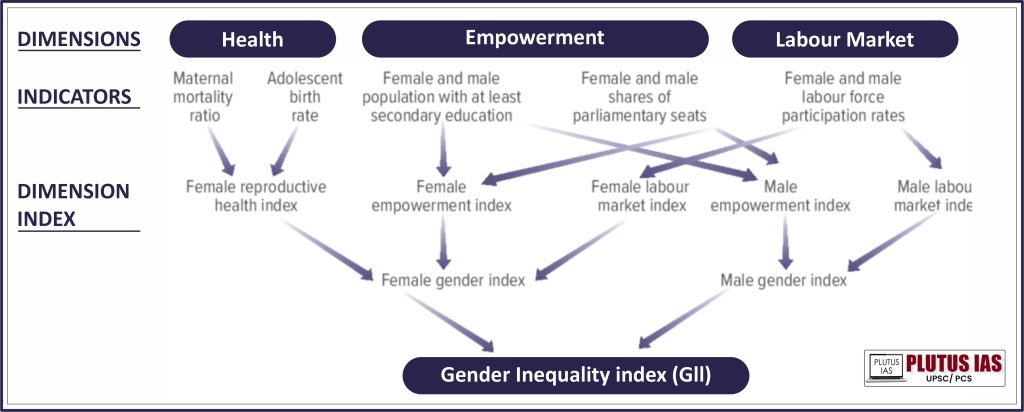21 Mar Gender Inequality Index 2022
This article covers ‘Daily Current Affairs’ and the topic details of ”Gender Inequality Index 2022″. This topic is relevant in the “Governance” section of the UPSC CSE exam.
Why in the News?
The Gender Inequality Index for 2022 was published by the UNDP as part of their Human Development Report for 2023/2024 on March 13, 2024. India is ranked 108th out of 193 countries. Compared to the Gender Inequality Index of 2021, where India ranked 122nd out of 191 countries, there is a notable improvement of 14 ranks in the 2022 index.
About the Gender Inequality Index
The Gender Inequality Index (GII) is a comprehensive metric that measures gender inequality in three major areas: reproductive health, empowerment, and the labour market. This index serves as a vital tool to gauge the level of gender inequality within a society, shedding light on the gaps between men and women in various aspects of life.
Dimensions of the Gender Inequality Index
- Reproductive Health: This dimension is evaluated based on indicators such as the maternal mortality ratio and the adolescent fertility rate. It highlights the health outcomes and challenges faced by women in terms of reproductive well-being.
- Empowerment: The empowerment dimension of the GII focuses on factors like the share of parliamentary seats held by each gender and levels of secondary and higher education attainment. It reflects the extent to which women are politically and educationally empowered within a society.
- Labour Market: Women’s participation in the workforce is a crucial aspect of the GII’s evaluation of the labour market dimension. It considers paid work, unpaid work, and the active pursuit of employment by women, providing insights into gender disparities in economic participation.

Interpretation of the Gender Inequality Index
- The GII ranges from 0 to 1, where 0 signifies gender equality, indicating that women and men fare equally, while 1 represents significant gender inequality, where one gender faces substantial disadvantages across all measured dimensions.
- Higher values on the GII indicate worse achievements in terms of gender equality, emphasising areas where improvements are needed to bridge the gender gap effectively.
Implications of Gender Inequality
- Gender inequality restricts women’s opportunities, freedom, and interactions with others, impacting their ability to access resources, make independent decisions, and contribute to society.
- Low status and inequality can have detrimental effects on women’s physical and mental health, autonomy, and control over household resources, ultimately affecting their well-being and that of their children.
- Addressing gender inequality is crucial for promoting social development, economic growth, and overall well-being within a society.
Unequal Lives: The Many Faces of Gender Inequality in India
India, a nation of immense diversity, continues to grapple with significant gender inequality. While the country boasts progress in various sectors, disparities between men and women persist across various aspects of life.
- Unequal Access to Education: Girls are often denied schooling due to societal pressures and poverty. This lack of education limits their opportunities and perpetuates the cycle of inequality.
- The Patriarchal Shadow: Deep-seated patriarchal norms dictate that men hold primary power in society. This relegates women to domestic roles and hinders their participation in public spheres.
- Workplace Discrimination: Women face challenges in entering and advancing within the workforce. Unequal pay, lack of maternity benefits, and a rigid work environment discourage women’s professional aspirations.
- Violence Against Women: Domestic violence, sexual harassment, and honour killings are grim realities for many women in India. Fear of violence creates a climate of insecurity and restricts their freedom.
- Skewed Sex Ratio: India has a long-standing issue of a skewed sex ratio, with a preference for sons leading to female infanticide and sex-selective abortions. This imbalance has social and demographic consequences.
- Harmful Practices: Child marriage, dowry demands, and restrictions on mobility are deeply ingrained practices that limit girls and women’s agency and well-being.
Initiatives taken by the Indian Government to tackle Gender Inequality
- Beti Bachao, Beti Padhao: This flagship campaign aims to improve the sex ratio and promote girls’ education.
- Samagra Shiksha: This program ensures gender-inclusive quality education at all levels, with a focus on creating safe and girl-friendly schools.
- Stand-Up India: This scheme provides loans and support to women entrepreneurs, encouraging their participation in businesses.
- Mahila E-Haat: This online platform empowers women entrepreneurs and Self-Help Groups (SHGs) by facilitating market access for their products.
- One-Stop Centre (OSC) Scheme: These centres offer integrated support to women affected by violence, including legal aid, counselling, and medical assistance.
Download plutus ias current affairs eng med 21th March 2024
Prelims practise question
Q1. What dimensions does the Gender Inequality Index assess?
(a) Economic, social, and political
(b) Reproductive health, empowerment, and the labour market
(c) Education, employment, and healthcare
(d) Infrastructure, environment, and governance
Answer: B
Q2. In patriarchal societies, which of the following is often associated with the relegation of women to domestic roles and limited participation in decision-making processes?
(a) Gender fluidity
(b) Gender parity
(c) Gender asymmetry
(d) Gender segregation
Answer: D
Mains practise question
Q1. Compare and contrast India’s Gender Inequality Index score and rank with another country that has a similar population size, and speculate on the reasons behind any disparities or similarities.
I am a content developer and have done my Post Graduation in Political Science. I have given 2 UPSC mains, 1 IB ACIO interview and have cleared UGC NET JRF too.



No Comments